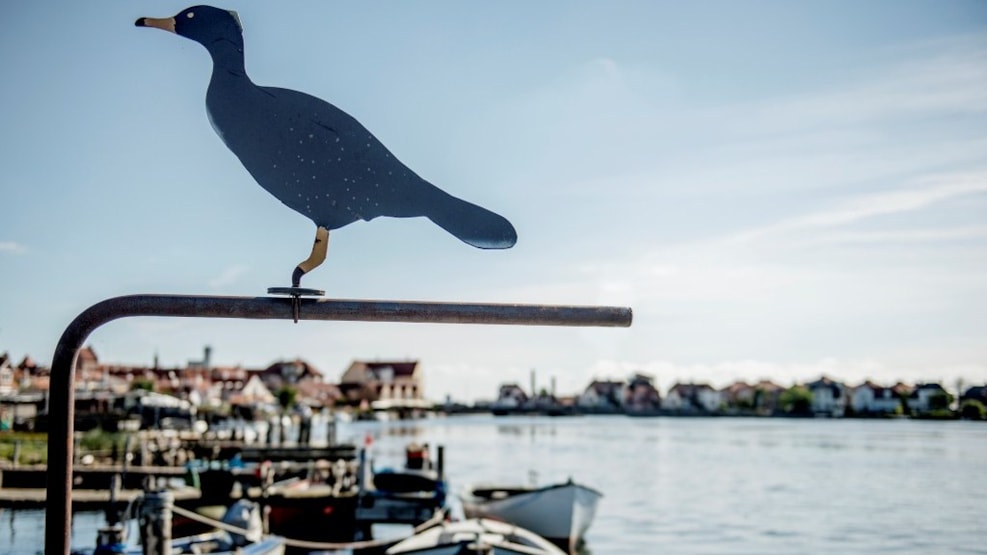
Town Walking Kerteminde
Experience charming Kerteminde yourself
The starting point for the tour is Tornøes Hotel, Strandgade.
Corner of Langegade / Hindsholmvej: Statue of Frederik Paludan-Müller. Danish poet (1809-1876), author of e.g. "Adam Homo". A commemorative plaque can be found on the house at Langegade 2.
Langegade 5-7 Andresens Gård. An exciting merchant farm which contains buildings from every century since the 16th century. Functioned as a grocery yard until the 1980s.
Kerteminde Parish Church is located in the middle of the square, rebuilt in late Gothic style in 1476. The three-aisled basilica-shaped church is gathered under one roof. Brochures about the church can be found in the armory, where the pallbearers' guild also stands. They are still used for the burial of guild members. The guild was founded in 1737.
Langegade is followed to Paludan Müllers Plads and then to the right along Fiskergade towards Lillestranden.
Lillestranden is an old fishing community, where some of the city's most attractive houses can be found. There is still fishing from here. The houses in Fiskergade down towards Lillestranden were previously almost exclusively inhabited by fishermen.
Fiskergade 83. Merchant and consul E.B. Muus established the Sailors' Foundation in 1880. It still provides housing for sailors and their families.
Note the beautiful old doors in Fiskergade. In the middle of the street is a small alley with the ironic name: Avenue des Champs Elysées.
Rebslagerstrade. The name is due to the fact that there used to be a ropes course on the site.
Vestergade 25. Built in 1694. Originally a merchant's farm, later a rectory and brewery. From 1950 used as headquarters for the Home Guard. In 1730, the then priest Johan Hornemann was murdered by his wife and her lover. The murderers were executed and their bodies placed on wheels and steeples.
Muusgården was built in the 1820s and functioned as a merchant's farm until the mid-1970s. The sideboard, which is part of the original merchant's farm, is a gem of local history and a cozy oasis for the thirsty.
Langegade 8. Farvergården, half-timbered house from 1630. The inscription above the gate says: "In the name of Jesus, Carsten Ifversøn and Anna Christoffersdatter had this house built in 1630".
Høkeren in Trollegade is an 18th-century building, which houses an exciting museum shop, which has been kept in the old style from the beginning of the 20th century.
Langegade 31 is an old half-timbered building that today houses a bank. The inscription reads: "Houses without the fear of the Lord soon become desolate. 1690".
On the opposite side of the street there is a city well, which was in use until the 18th century. It was found during the reconstruction of Langegade in 1994.
Langegade 37. The building was built as a school in 1905, but has been a pharmacy. The inscription means: Learning, initiation, medicine.
Cross the road and see Langegade 44C from 1780.
Langegade 50, built in 1883, was the childhood home of the painter Johannes Larsen.
Langegade 54. Note the old door from 1796.
The hole in the row of houses at the end of Langegade is due to the railway line Odense-Kerteminde-Martofte, which was closed in 1966.
Statue of John Christmas Møller, Danish conservative politician who fled to England in 1942.
The painter Johannes Larsen's home, today a museum. The villa was built in 1901. The Swan Mill, built in 1852, is the only remaining of 3 windmills on Møllebakken.
The Fjord and Belt Center at the harbor contains an underwater observatory, exhibitions and a kiosk. Guinea pigs and seals are fed several times a day.
When you cross Langebro towards Dosseringen, you see the city's landmark Amanda, on the right. The statue was created by the sculptor Robert Lund-Jensen in 1954.
Dosseringen. Restaurant Varmestuen was formerly a smokehouse.
Next to the good fish restaurant Rudolf Mathis there is a bridge with old sailing ships. Note especially "Rylen", the belt boat which was Johannes Larsen's and Achton Frii's expedition ship to "De Danskes Øer".
Strandgade 3. Toldboden is a beautiful stone house from 1590, rebuilt in 1735. Art and cultural history exhibitions are shown in the house. Free access.
Strandgade 2. Tornøes Hotel has operated a hotel business since 1860.